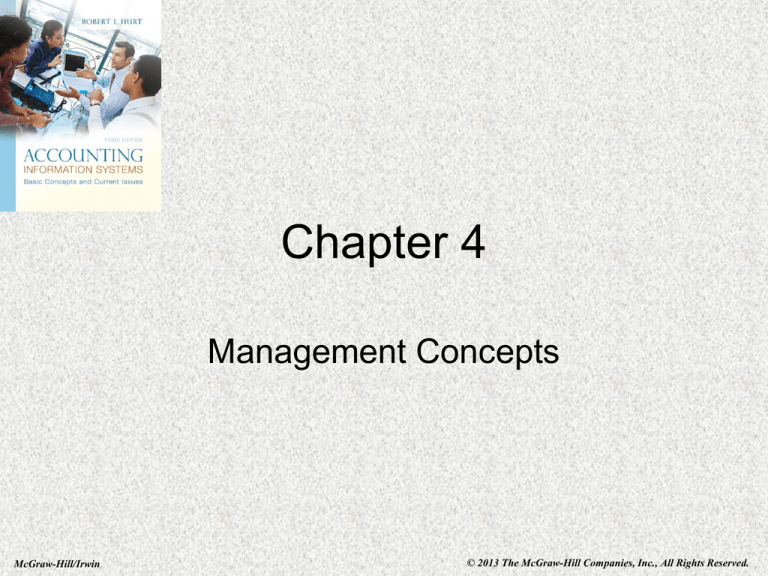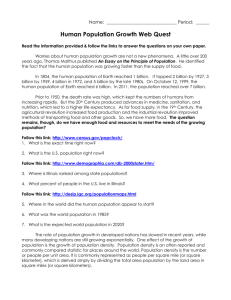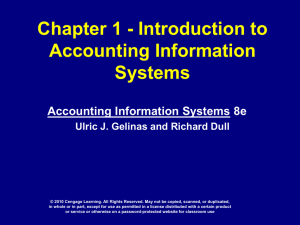
Chapter 4
Management Concepts
McGraw-Hill/Irwin
© 2013 The McGraw-Hill Companies, Inc., All Rights Reserved.
Outline
• Expected outcomes
• Importance in AIS
• Enterprise Risk Management framework
• Business process management
• Expectancy theory
4-2
Expected outcomes
• Summarize and explain the importance of COSO’s
Enterprise Risk Management Integrated Framework.
• Define business process management, including a
generalized model of BPM.
• List and discuss some basic principles of business
process management.
• Explain expectancy theory.
• Apply all three topics within the context of accounting
information systems.
4-3
Importance in AIS
• AIS is interdisciplinary at its core.
– Accounting and finance
– Management and organizational behavior
– Information technology
• Humans are an integral part of any AIS.
• AIS focuses on business processes.
• People can behave in unusual ways when
dealing with AIS issues.
4-4
ERM framework
• A second publication from COSO
• Not as well received as the Internal
Control framework
– Necessarily less specific than internal control
framework
– Published around the time SOX became law
• Does not supplant the internal control
framework
4-5
ERM framework
Internal environment
Monitoring
Objective setting
Enterprise Risk
Information &
communication
Management—
Event identification
Integrated Framework
Control activities
Risk assessment
Risk response
4-6
ERM framework
• Lecture break 4-1
Form a group of three to five students.
Consider one or more of the following
questions:
• How are the two COSO frameworks similar?
Different?
• Why is the ERM framework necessarily less
specific?
• How could the ERM framework gain wider
acceptance?
4-7
Business process management
• A systematic
approach to
analyzing,
• Processes include:
– Sales / collection
– Acquisition / payment
– Financing
redesigning,
– Conversion
improving and
– Human resources
managing a specific
process
Those five processes are
discussed later in the
text.
4-8
Business process management
• Generalized model of
BPM
– Select the process and
define its boundaries.
– Observe, document
and map the process
steps and flow.
– Collect processrelated data.
– Analyze the collected
data.
– Identify and prioritize
potential process
improvements.
– Optimize the process.
– Implement and
monitor process
improvements.
Lecture break 4-2. Identify one
process at your university that
could be improved. Complete as
many of the steps in the
generalized model as you can.
4-9
Business process management
• Principles of BPM
– Understand interaction
with organizational
strategy.
– Be open to
alternatives.
– Avoid too much
reliance on external
consultants.
– Ensure consultants’
tasks are well defined.
– Communicate!
– Enlist top
management support.
– Hire people who see
the “big picture.”
4-10
Expectancy theory
• Proposed by Vroom
as a way of
understanding human
motivation
• Motivation =
Expectancy X
Instrumentality X
Valence
• Note that factors are
multiplied, not added
• Expectancy
Will effort lead to
success?
• Instrumentality
Will success be
rewarded?
• Valence
Do I value the reward?
4-11
Expectancy theory
• Lecture break 4-3
What tasks associated
with AIS could be
usefully analyzed via
expectancy theory?
4-12
Classroom assessment
• In this lecture, we’ve
examined the
following topics:
– Enterprise risk
management
– Business process
management
– Expectancy theory
• Consider the process
you used to purchase
your AIS textbook.
– What risks did it entail?
How did you manage those
risks?
– How could the process be
improved?
– Use expectancy theory to
analyze your motivation to
buy the book.
4-13
4-14







